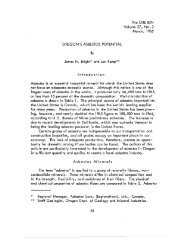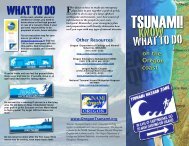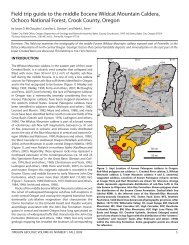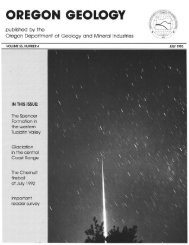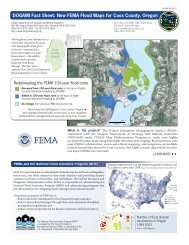Ore Bin / Oregon Geology magazine / journal - Oregon Department ...
Ore Bin / Oregon Geology magazine / journal - Oregon Department ...
Ore Bin / Oregon Geology magazine / journal - Oregon Department ...
You also want an ePaper? Increase the reach of your titles
YUMPU automatically turns print PDFs into web optimized ePapers that Google loves.
State of <strong>Ore</strong>gon<br />
<strong>Department</strong> of <strong>Geology</strong><br />
and Mineral Industries<br />
1069 State Office BI dg.<br />
Portland <strong>Ore</strong>gon 97201<br />
The ORE BIN·<br />
Volume 34,no. 10<br />
October 1972<br />
FOSSil SHARKS IN OREGON<br />
Bruce J. Welton*<br />
Approximately 21 species of sharks, skates, and rays are either indigenous<br />
to or occasionally visit the <strong>Ore</strong>gon coast. The Blue Shark Prionace glauca,<br />
Soup-fin Shark Galeorhinus zyopterus, and the Dog-fish Shark Squalus<br />
acanthias commonly inhabit our coastal waters. These 21 species are<br />
represented by 16 genera, of which 10 genera are known from the fossi I<br />
record in <strong>Ore</strong>gon. The most common genus encountered is the Dog-fish<br />
Shark Squalus.<br />
The sharks, skates, and rays, (all members of the Elasmobranchii) have<br />
a fossil record extending back into the Devonian period, but many major<br />
groups became extinct before or during the Mesozoic. A rapid expansion<br />
in the number of new forms before the close of the Mesozoic gave rise to<br />
practically all the Holocene families living today. Paleozoic shark remains<br />
are not known from <strong>Ore</strong>gon, but teeth of the Cretaceous genus Scapanorhynchus<br />
have been collected from the Hudspeth Formation near Mitchell,<br />
<strong>Ore</strong>gon.<br />
Recent work has shown that elasmobranch teeth occur in abundance<br />
west of the Cascades in marine Tertiary strata ranging in age from late<br />
Eocene to middle Miocene (Figures 1 and 2).<br />
All members of the EIasmobranchii possess a cartilaginous endoskeleton<br />
which deteriorates rapidly upon death and is only rarely preserved in the<br />
fossil record. Only under exceptional conditions of preservation, usually<br />
in a highly reducing environment, will cranial or postcranial elements be<br />
fossilized. The hard outer enamel of all sharks teeth enables them to resist<br />
weathering and transportation prior to deposition. Considering this fact and<br />
also the fact that tooth progression and replacement in the elasmobranchs<br />
is a perpetual process which continually contributes teeth to nearby sediments,<br />
it is no wonder that teeth constitute almost 100 percent of all the<br />
shark material found in <strong>Ore</strong>gon.<br />
* Student, <strong>Department</strong> of Earth Sciences, Portland State University<br />
161







